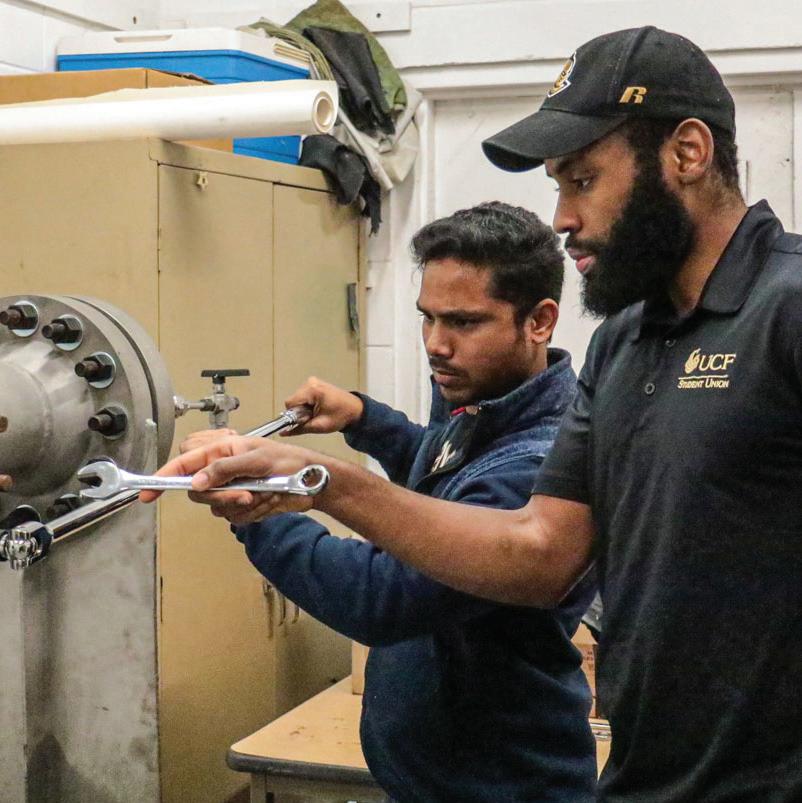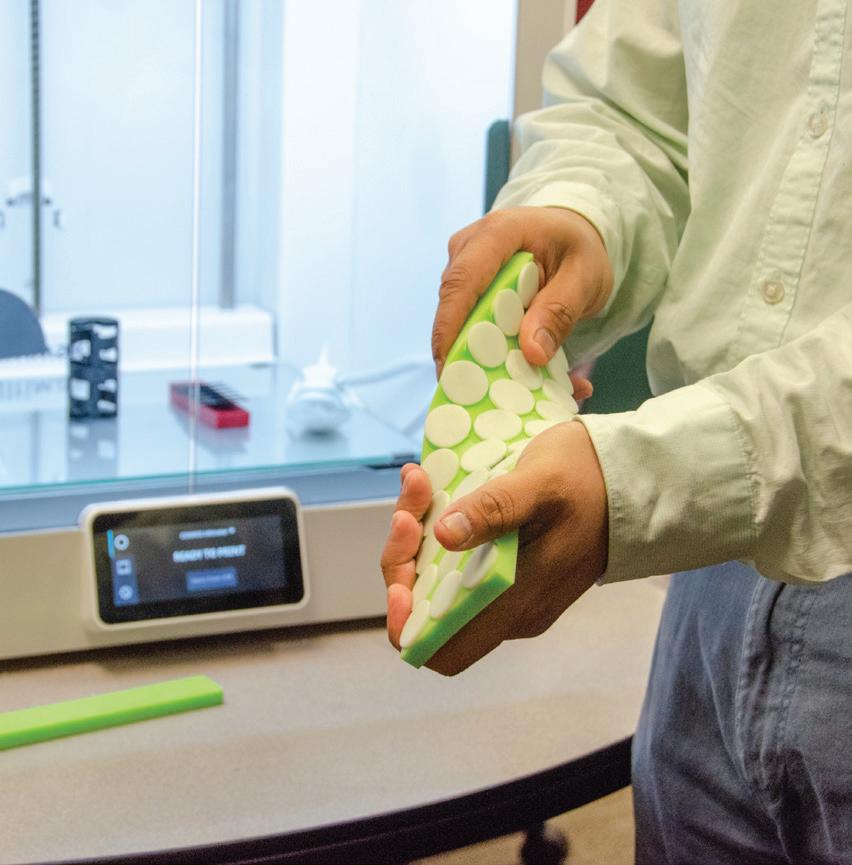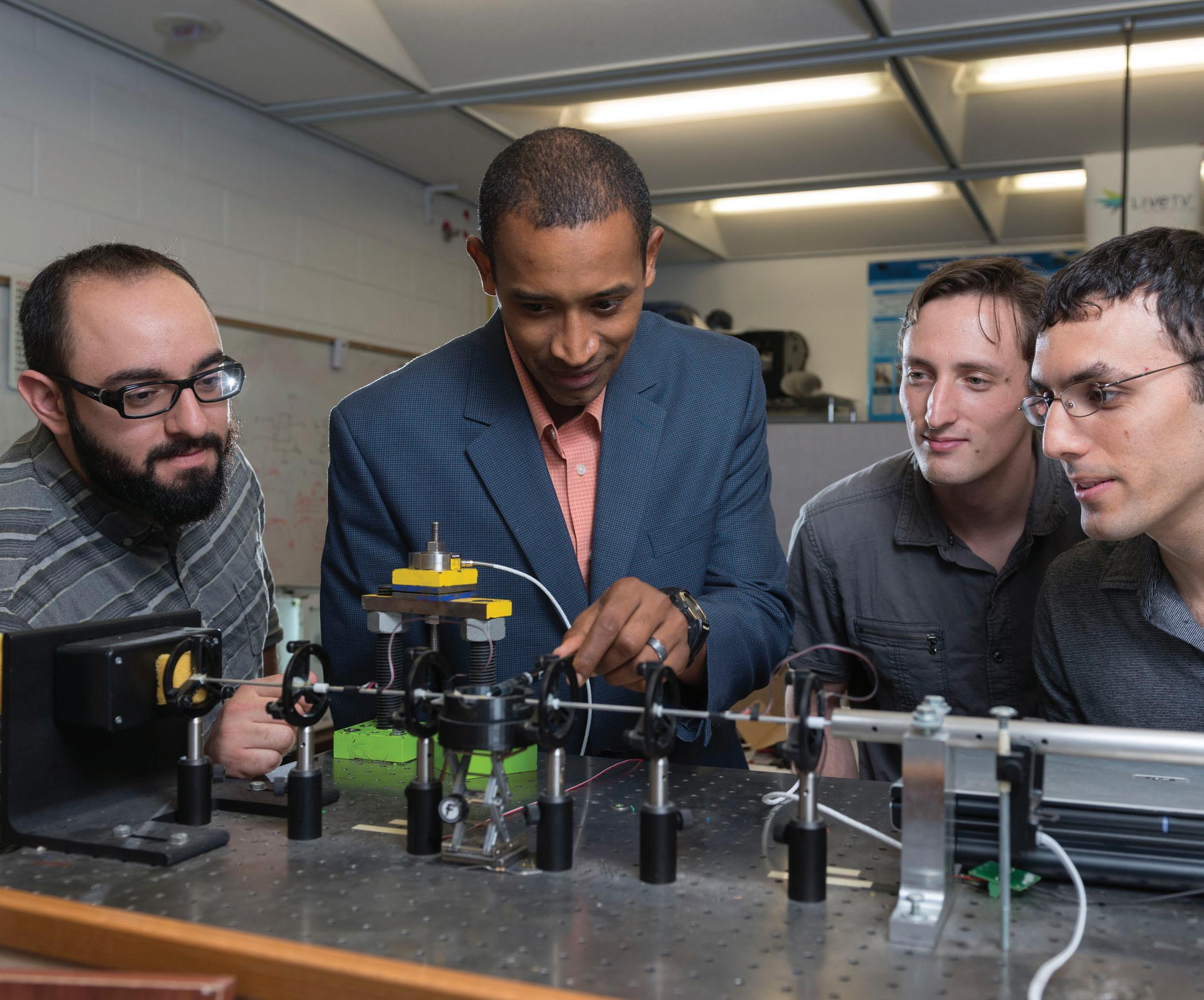
DEPARTMENT OF MECHANICAL AND AEROSPACE ENGINEERING UNIVERSITY OF CENTRAL FLORIDA • ORLANDO, FL Aerospace Engineering Research 1
Astrodynamics and Space Robotics Lab......................................................4 Center for Advanced Turbomachinery and Energy Research...............6 Conputational Fluids and Aerodynamics Lab.............................................8 Composite Materials and Structures Lab....................................................10 Complex Structures and Mechanics of Solids Lab...................................12 Experimental Fluid Mechanics Lab................................................................14 Mechanics of Materials Research Group.......................................................16 Propulsion and Energy Research Lab...........................................................18 Structures and Materials Design Lab...........................................................20 Vasu Lab...................................................................................................................22 CONTENTS
LAB DIRECTORY
Astrodynamics and Space Robotics Lab
Tarek Elgohary
Assistant Professor
elgohary@ucf.edu
mae.ucf.edu/TAE
Center for Advanced Turbomachinery and Energy Research
Jayanta Kapat Professor and Director
jayanta.kapat@ucf.edu
cater.cecs.ucf.edu
Computational Fluids and Aerodynamics Lab
Michael Kinzel
Assistant Professor michael.kinzel@ucf.edu
mae.ucf.edu/CFAL
Composite Materials and Structures Lab
Jihua Gou Professor
jihua.gou@ucf.edu
mae.ucf.edu/CMSL
COSMOS Lab
Ranajay Ghosh
Associate Professor
ranajay.ghosh@ucf.edu
mae.ucf.edu/cosmos
Experimental Fluid Mechanics Lab
Samik Bhattacharya
Assistant Professor
samik.bhattacharya@ucf.edu
mae.ucf.edu/EFML
Mechanics of Materials Research Group
Ali Gordon Professor
ali.gordon@ucf.edu
momrg.cecs.ucf.edu
Propulsion and Energy Research Lab
Kareem Ahmed Associate Professor kareem.ahmed@ucf.edu
mae.ucf.edu/PERL
Structures and Materials Design Lab
Kawai Kwok
Assistant Professor
kawai.kwok@ucf.edu
mae.ucf.edu/kawaikwok
Vasu Lab:
Combustion, Propulsion, Laser Diagnostics, Absorption Sensors and Fuels
Subith Vasu Professor subith@ucf.edu mae.ucf.edu/VasuLab
3



ASRL Lab

Astrodynamics and Space Robotics Lab
Led by: Tarek Elgohary, Ph.D.
At the intersection of dynamics, control and computational methods, you’ll find the research conducted in the Astrodynamics and Space Robotics Lab. With a focus on space flight applications, Assistant Professor Tarek Elgohary and his research team tackle various guidance, navigation and control problems applied to orbital mechanics, autonomous space proximity operations, space situational awareness and robotics.
One of the current projects in the lab is ROME, a Raid Orbit Motion Emulator. This compact ground vehicle is coupled with a robotic arms to emulate the motion of spacecraft in orbit and to simulate docking maneuvers.
Other work includes simulations and robotics experiments to push the boundaries of the field of space flight.
5



CATER
Center for Advanced Turbomachinery and Energy Research
Led by: Jayanta Kapat, Ph.D.
The University of Central Florida lies in the heart of the state, at the center of the Turbine Turnpike. There’s no better setting for the Center for Advanced Turbomachinery and Energy Research, led by Pegasus Professor and Director Jayanta Kapat.
CATER Is comprised of a group of core faculty researchers that include the Department of Mechanical and Aerospace Engineering’s aerospace engineering faculty, as well as postdoctoral researchers, graduate students and undergraduate students.
The researchers have developed close ties with many major engineering companies located near the university including GE Global Research, Aerojet Rocketdyne and Embraer. Siemens has also provided several multi-million dollar grants to fund the construction of the Siemens Energy Center, which exclusively houses CATER-related research projects. The 10,000-square-foot space houses laboratories as well as well as state-of-the-art equipment inclding high performance computers and software, scientific cameras, and more.

7



CFAL Lab

Computational Fluids and Aerodynamics Lab
Led by: Michael Kinzel, Ph.D.
Whether it’s the fluid mechanics of a human bone or a next generation aerial vehicle, Assistant Professor Michael Kinzel uses his knowledge and expertise to come up with innovative solutions to problems related to fluids and aerodynamics. His team in the Computational Fluids and Aerodynamics Lab is a major contributor to NASA’s Dragonfly mission, which aims to land an octocopter on Titan, Saturn’s largest moon. The team also explores the area of entry, landing and descent and is working on designs for a nextgenerations capsule that can better manage heat and aerodynamics, or deliver payloads around the world in less than an hour.
But Kinzel’s work doesn’t just focus on faster, more efficient spaceflight. His team is also exploring the intricate details of inner bone fluids mechanics to discover how it drives bone health, with applications for astronauts in space as well as for patients with bone implants. Here, the team uses high-end computations as well as flight testing in microgravity.
9



CMSL Lab
Composite Materials and Structures Lab
Led by: Jihua Gou, Ph.D.
The most advanced composite materials are used in the design and construction of aircraft and spacecraft. In the Composite Materials and Structures Lab, led by Professor Jihua Gou, those materials and structures are designed, processed, tested and analyzed.
The overarching goal of the lab is to create the most state-of-the-art capabilities for the creation and study of composite materials, as well as to provide a knowledge and technology base for the application of composites in aircraft and spacecraft, energy, ships, prosthetics, and automotive and sports goods.
Gou’s current projects are funded by NASA, the Department of Energy, the Federal Aviation Administration and the National Science Foundation. He and his team collaborate with industries and government laboratories including Boeing Co., the Air Force Research Laboratory, NASA’s Marshall Space Flight Center and the Kennedy Space Center.

11



COSMOS Lab

Complex Structures and Mechanics of Solids Lab
Led by: Ranajay Ghosh, Ph.D.
Why don’t animals get dirty? Why don’t fish ever lose their scales?
In the COSMOS Lab, Associate Professor Ranajay Ghosh and his research team explore the answers to these questions, which could help engineers design stronger, more durable materials.
The secrets lie in the geometry of hair, fur, feathers and even fish scales. Ghosh studies their properties and behaviors to determine how to best replicate them in new, synthetic materials. With the knowledge of how fish scales can grip and move across surfaces, or how much stress and pressure they endure during a shark bite, better materials for robotics and exoskeletons can be created. This could also lead to the development of foldable, stackable structures that expand when shot into space.
Ghosh currently collaborates with Siemens to create snakelike robots that can be used for turbine inspection. These robots, equipped with borescopes, can fit and maneuver safely within all of the nooks and crannies of the turbine, leading to a more effective and efficient inspection. They can be combined and stacked together to create varying lengths, and can also be useful during search and rescue missions.
13



EFML Lab
Experimental Fluid Mechanics Lab
Led by: Samik Bhattacharya, Ph.D.
Many airplane passengers grit their teeth, white-knuckle their armrests and say a silent prayer for their flight to go smoothly. They know that any sudden disturbance in airflow can cause turbulence — and in turn, a severe case of anxiety.
But in smaller aircraft, such as unmanned aerial vehicles or micro air vehicles, turbulence is more than a bumpy ride. It can severely affect the stability of these vehicles and cause them to lose control. On the other hand, nature’s natural fliers — birds — know how to retain control during airflow disturbances.

Assistant Professor of Aerospace Engineering Samik Bhattacharya is studying the morphing power of bird wings in turbulence through a three-year, $441,000 grant from the U.S. Air Force Office of Scientific Research. The goal is to uncover the secrets of bird stability and engineer a comparable solution for UAVs and MAVs.
Bhattacharya and his team are also studying the perching manuevers of birds and their implications for aircraft design. With the aid of 3D printed wings and a towing tank, the team at the EMFL lab are ready to uncover the secrets of avian flight and how they can transform modern aviation.
With the support of a National Science Foundation CAREER Award, team is also uncovering the mechanics of manta rays and how they can be applied unmanned underwater vehicles.
15



MOMRG Lab
Mechanics of Materials Research Group
 Led by: Ali Gordon, Ph.D.
Led by: Ali Gordon, Ph.D.
The hottest components of a machine dictate the life of a structure. If designers know how long materials will last in extreme environments, they can manufacture more durable machines. With the aid of continuum-level models, Professor Ali Gordon and his team in the Mechanics of Materials Research Group estimate the behaviors of essential materials to extend the life and reliability of aircraft and spacecraft. They continually master novel techniques in experimental, computational and theoretical mechanics while individually applying that knowledge to break ground on specific problems.
17



PERL Lab

Propulsion and Energy Research Lab
Led by: Kareem Ahmed, Ph.D.
What if you could travel from New York to California in 30 minutes or less? That fantasy could become a reality through the research conducted in the Propulsion and Energy Research Lab.
Assistant Professor Kareem Ahmed leads a large research team that investigates multiphase turbulent reacting flows, clean combustion strategies, hypersonic and supersonic compressible reacting flows, and alternative fuels for the next generation advanced propulsion and combustion energy technologies. The PERL Lab is the only lab in the nation that is equipped with a turbulent shock tube for testing hypersonic reactions.
The team’s recent discovery — that subsonic flames can be turned into hypersonic flames with a little turbulent mixing — could open the door for air travel five times faster than the speed of sound. The science behind is this is key to a second discovery — the mechanism behind supernovae explosions, used by scientists for models to understand the origin of the universe.
Ahmed’s research has been recognized by Science magazine, the Combustion Institute and the Department of Defense. He has also garnered more than $6.47 million in research funding from organizations such as NASA, Siemens, the Department of Energy and Aerojet Rocketdyne, that will allow him to further develop his research on hypersonic travel.
19



SMD Lab
Structures and Materials Design Lab
Led by: Kawai Kwok, Ph.D.
Sending devices into space is tricky — they are large in size but rocket cargo space is small. Imagine fitting a structure the length of a Boeing 737 into a truck compartment. This is the challenge undertaken by the research group of Assistant Professor Kawai Kwok.
In the Structures and Materials Design Lab, Kwok and his team use innovative concepts to design deployable spacecraft structures that can be efficiently packaged inside the payload volume of launch vehicles and reliably deployed to their functional size in orbit.
Through a combination of computational modeling, experimental characterization and prototype fabrication, Kwok and his team seek to explain the underlying mechanics of thin-shell structures and advanced composite materials, and come up with novel structure designs.
The SMD Lab closely collaborates with NASA and a few aerospace companies specializing in deployable space systems and composite material solutions.

21



Vasu Lab:

Combustion, Propulsion, Laser Diagnostics, Absorption Sensors and Fuels
Led by: Subith Vasu, Ph.D.
Not too many researchers would venture inside of a fire, but that’s exactly what Associate Professor Subith Vasu has done. With his research team in the Vasu Lab, he has developed a method that uses lasers to measure the temperature, as well as the concentrations of different molecules, in such a high-heat environment. This method could aid researchers in fighting fires and explosions, advanced energy conversion strategies using supercritical CO2, and creating cleaner, more efficient engines for space travel.
This method was also instrumental in Vasu’s recent work on the proper destruction of chemical weapons, sponsored by the Defense Threat Reduction Agency. Vasu has also received a $1 million Young Faculty Award from DARPA to develop a handheld device that can detect trace amounts of fentanyl, along with deadly toxins that result from chemical warfare. Vasu Lab has garnered more than $10 million in research funding and recognized by multiple professional agencies and international agencies including U.N. Currently, the lab has ongoing research projects from FAA, NASA, DOE, Air Force, Navy, Army, DARPA, DTRA, and several industries.
23
FOR MORE INFORMATION: MAE.UCF.EDU MAEADVISING@UCF.EDU 407.823.2416 UNIVERSITY OF CENTRAL FLORIDA DEPARTMENT OF MECHANICAL AND AEROSPACE ENGINEERING COLLEGE OF ENGINEERING AND COMPUTER SCIENCE P.O. BOX 62450 ORLANDO, FLORIDA 32816-2450
































